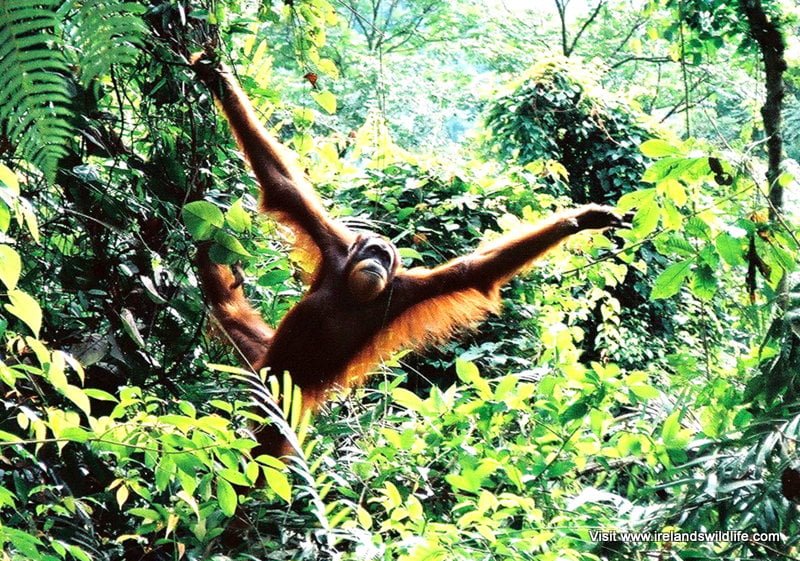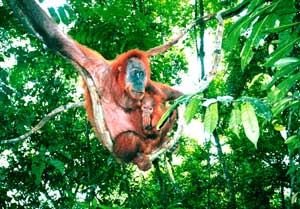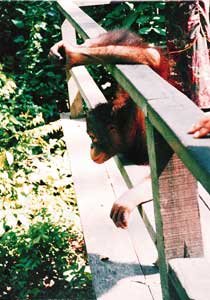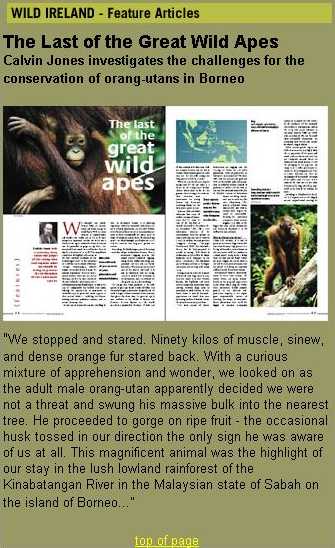This is a feature about the conservation of the orang-utan that I originally wrote for “Wild Ireland” magazine back in 2003. Ten years on and the great red ape is still hanging on, barely.

We stopped and stared. Ninety kilos of muscle, sinew and dense orange fur stared back.
With a curious mixture of apprehension and wonder we looked on as the adult male orang-utan apparently decided we were not a threat and swung his massive bulk into the nearest tree. He proceeded to gorge on ripe fruit — the occasional husk tossed in our direction the only sign he was aware of us at all. This magnificent animal marked the highlight of our four-night stay in the lush lowland rainforest of the Kinabatangan River in the Malaysian state of Sabah on the island of Borneo.
Sungei Kinabatangan, Sabah’s longest river, winds its way through the lowland dipterocarp forest of north-eastern Borneo. Piracy and the risk of flooding have left the lower reaches of the river comparatively undeveloped, and it still boasts exceptional biodiversity. A visit to the area is unforgettable for wildlife enthusiasts, offering the opportunity to experience an incredible array of plant and animal species in their natural habitat — including that bizarre-looking Borneo endemic the proboscis monkey, and of course the orang-utan.

And yet my trip to Borneo haunts me for more disturbing reasons. Travelling by road in Malaysian Borneo is a sobering experience. Mile after inexorable mile all you can see is oil palm plantations and denuded hillsides where forest has been cleared to accommodate yet more of them. Occasionally you spot a patch of forest thrusting its canopy above the encroaching palm — an island besieged on all sides. You can’t help but wonder how long such pockets can survive.
Even along the Kinabatangan, one of the orang-utan’s last refuges in Malaysian Borneo, there is substantial logging activity. We passed several makeshift logging-camps where timber was being pre-processed, tied into rafts and floated downriver. When you see even a small a part of the picture first-hand it is easy to understand how the orang-utan is in trouble, but the full extent of the devastation man has inflicted on this gentle ape is truly disturbing.
The orang-utan (Pongo pygmaeus) is the only species of great ape found outside Africa, the second largest primate after the gorilla, and the world’s largest arboreal mammal. Once common throughout Southeast Asia, the great red ape is now confined to the islands of Borneo and Sumatra. Current figures put the world population somewhere between 15,000 and 25,000 animals, with about a third occurring in Sumatra and the rest in Borneo. Some experts predict that we may see the last wild orang-utan disappear in as little as a decade.
While the practice of capturing live orang-utans for the pet trade is a factor in the orang-utan’s decline, habitat destruction is by far the greatest threat. Orang-utan conservation therefore concentrates on saving Borneo and Sumatra’s remaining forests, but the facts paint a grim picture.
Between 1968 and 2000 Indonesia lost some 40 million hectares of forest — more than 5½ times the area of the Republic of Ireland! An article in The Jakarta Post on 10 December 2001 cites Indonesian Ministry of the Environment statistics giving an annual deforestation rate of between 2 and 2.4 million hectares per year. Longgena Ginting, campaign director with Walhi (the Indonesian Forum for the Environment) is quoted as saying: “The forest in Kalimantan, which suffers the fastest depletion, could disappear in five years”. Kalimantan, the Indonesian part of Borneo, is home to the largest proportion of surviving wild orang-utans.

Orang-utans roam widely in search of food and need large tracts of uninterrupted forest to survive. Physical barriers, like highlands and rivers, prevent orang-utan populations from moving between large areas of potentially suitable habitat. As their forest home is steadily destroyed populations are forced into ever-decreasing pockets of isolated habitat that simply cannot support them.
The main sources of habitat destruction are logging and the clearing of forest for oil palm plantations. Palm oil production in Indonesia has increased by 57% since 1993, and the country now accounts for 31% of the world’s palm oil production, second only to Malaysia. Global demand is predicted to rise by a further 50% in the next five years and some 200,000 to 250,000 hectares of Indonesia’s forests are being cleared each year to make way for new plantations. The widely publicised forest fires of 1997 and 1998 in Borneo were largely the result of uncontrolled burning by plantation companies. Some sources suggest up to 80% of the larger fires were deliberately started in this way, and eventually destroyed 5 to 10 million hectares of forest.
What has this got to do with us?
It is easy, given such statistics, to point an accusatory finger from afar and claim the moral high ground. But having obliterated our own forests in the past are we really in a position to criticise people trying to eke a living from the land around them? Before we start to point fingers we should look at the role the international community has played in funding the atrocities inflicted on Southeast Asia’s forests.
International financial institutions, many of them from Europe, the United States and Japan, invested heavily in the pulp and paper sector in Southeast Asia during the 1990s. That investment fuelled massive growth in the industry, and production capacity in the region grew exponentially. Instead of investing the money in sustainable forest plantations that could be logged in rotation, companies continued to exploit the “free” timber of the rainforest. Of the estimated 100 million m³ of wood consumed by the pulp and paper industry in Indonesia between 1988 and 1999 an estimated 8% was harvested from sustainable plantations; the remaining 92% was sourced mainly by clear-cutting rainforest.

But what has all this got to do with us here in Ireland? While Ireland-specific figures are difficult to come by, it is likely a proportion of the paper and wood products that we use every day are ultimately sourced from the forests of Sumatra and Borneo. Check the packaging of the paper you are using in your office photocopier or printer, or the writing paper you have in your desk drawer at home. Chances are that the packaging will not identify the origin of the timber used to make the paper. The truth is that most of the time we do not know what we are buying when it comes to paper — and cheap paper could quite literally be costing the earth.
According to Friends of the Earth our nearest neighbour, the UK, imports 20% of the illegally sourced tropical wood entering the EU. In 1999 5.4 million m³ of illegally sourced Indonesian wood products entered the UK — a figure that translates directly to the illegal felling of around 50,000 hectares of tropical rainforest.
Because of increasing environmental awareness in Europe and the United States many of Southeast Asia’s pulp and paper companies have developed marketing strategies designed to obscure the origin of their products on the global market. Many paper products that originate in Southeast Asia are distributed in the UK un-branded, or are re-branded by the UK distributors, usually with no indication of the sustainability of the source or the country of origin. Friends of the Earth estimate that up to 50% of the UK’s wholesale stationary supply business is contaminated with Indonesian paper sourced ultimately by clear-cutting rainforest. Some of that paper inevitably ends up here in Ireland.
So by buying paper or wood products that do not explicitly identify a sustainable source, and by buying products containing palm oil (used in many food products), we are indirectly contributing to the destruction of the orang-utan’s habitat. At the moment the all-powerful consumers of Western Europe and the United States continue to be part of the problem, rather than the solution.
The Solution?
What can we do to turn this nightmare around and offer the orang-utan at least a fighting chance of survival? Dr Gary Shapiro, Vice President of Orangutan Foundation International (www.orangutan.org), feels that the biggest challenge facing orang-utan conservation groups today is coordination and cooperation between the different parties involved in the conservation effort, and securing adequate funding to implement creative and innovative projects that can make a real difference.
“It is important that the various conservation groups support each other,” he said. “The enemy is very clear: greed, ignorance, poverty and cultural inertia.”
Dr Shapiro also wants to see increased funding for projects that will directly help orang-utan survival, like the Great Ape Conservation Fund in the USA and the United Nations’ Great Ape Survival Project (GrASP — www.unep.org/grasp), and encourages further funding initiatives from the corporate and philanthropic world.
“Giving people alternative jobs rather than illegal logging, those that are beneficial or benign to the environment, is key — and ensuring that greedy logging bosses do not fill the void with other poor people is essential,” he said, going on to highlight the need to combat illegal trade through improved enforcement, and for local education programs — all of which takes substantial funding.
Dr Cheryl Knott, Assistant professor of Anthropology at Harvard University has been studying orang-utans in Kalimantan since 1992. She believes that the biggest threats facing orang-utan conservation “on-the-ground” in Kalimantan are illegal logging and lack of law enforcement. Logging is rampant in Kalimantan’s national parks, and local authorities are cashing in by levying taxes on the illegal timber.

According to Dr Knott the authorities do not even have the support of the local communities. “Before the regional autonomy, it used to be just the government, military and police exploiting the natural resources. Now local business opportunists and villagers are getting their opportunity to get a cut in what they could only watch get exploited before.”
Simply introducing and enforcing regulations in these areas will not work. You can not tell a local to stop the work that’s feeding his family so that an orang-utan will be better off. What you can do is educate local communities about the destructive nature of indiscriminate logging, teach them about the value of the forest and of the species it supports, instil in them an understanding of their role as custodians of this precious resource and, most importantly of all, provide them with a realistic and demonstrably sustainable alternative to support their families.
In some areas of Borneo and Sumatra eco-tourism is playing an important role in providing just such an alternative. Rehabilitation centres have been established in both Malaysia and Indonesia and work to reintroduce orphaned and confiscated orang-utans to the wild. Some of these centres are open to the public, and allow people to get close to the animals and to learn more about the issues surrounding orang-utan conservation. These centres provide jobs, attract international tourists, help fund conservation programmes and inject both foreign and local currency into the local economy.
Other eco-tourism ventures, like the Borneo Rainforest Lodge in the Danum Valley Conservation Area, Sabah, specialise in natural history “experiences”. These include guided interpretive nature treks, marked nature trails and canopy walkways, letting visitors get up-close and personal with the rainforest in relative comfort. Models like these are invaluable, as they demonstrate real alternatives to destroying the forest.
“Eco-tourism shows the population, and the government, that the orang-utans and the forest provide jobs that will be sustainable. Nothing is lost by eco-tourism if it’s done correctly,” said Dr Shapiro.
When you combine complex local issues, international financial interests and a global demand for cheap wood and palm oil products you begin to see the scale of the problem facing conservation groups. Conservation efforts will need to increase dramatically and become more effective if they are to reverse the orang-utan’s decline.
From Malaysian Borneo there is at least a sliver of positive news. In March 2002 a survey conducted as part of an environmental impact assessment for a proposed pulp and paper joint venture found surprisingly high densities of wild orang-utan. The area, in the northeast corner of Kalabakan near the Danum Valley in Sabah, was logged 20-25 years ago, but has shown excellent regeneration since then. Orang-utans have taken advantage of this good secondary growth and the survey suggests that the area may now harbour one of the world’s highest densities of orang-utans.
So perhaps, given the opportunity, both the forests of Malaysia and Indonesia, and the orang-utan populations that they support, can recover from decades of human abuse. But for that to occur we need to provide that opportunity — and at the moment that is just not happening.
What can we do to help?

The single most important thing we can to assist the orang-utan conservation effort is to boycott any product that could be linked to the destruction of Southeast Asia’s forests.
Professor Birute Galdikas has been studying orang-utans in Borneo since 1971 and is arguably the world’s foremost expert on the species. As founder and president of Orangutan Foundation International, Prof Galdikas urges all of us to get involved in the struggle to save these animals.
“The American and the European consumer are powerhouses,” she says on the OFI’s website, “and if they demand in the market-place that timber would be labelled with country of origin and where it actually came from, managed forest or ancient growth forest, then this would have real repercussions in the real world.” She also stresses that one of the most important things we can do is write to our political representatives, urging them to support any initiative that will help protect tropical rainforests throughout the world.
Dr Shapiro suggests that people in Ireland can help in other ways too. “Support organisations like OFI and Orangutan Foundation UK (www.orangutan.org.uk)…. Also participate in eco-tourism programs such as OFI’s 11-day Study-Support-Tour. Support conservation with your feet and your pocketbook. Together we can make sure that orang-utans will continue as a species.”
Orang-utans are teetering on the brink of extinction, but they are not gone yet. Given the right circumstances, and plenty of time, wild orang-utan populations can still recover. Their future, it seems, like that of so many other species on this planet, is firmly in our hands.
Things you can do to help
- Boycott products likely to have an impact on the world’s rainforests (see Things to avoid).
- Write to your TDs and to the Minister for the Environment and urge them to support initiatives that will help to protect the world’s rainforests.
- Support orang-utan conservation groups through financial donations and by participating in eco-tourism projects that they promote.
Things to avoid
- Paper — Only buy paper products that are clearly labelled showing that they are from a sustainable source. Raise the issue in your place of work.
- Tropical Plywood — Indonesia supplies 90% of the global trade in tropical plywood. There are currently no sustainable tropical plywood projects in the country. Consider certified alternative materials instead.
- Dowels — These are used as handles for tools (rakes, brooms, mops, etc.) and are often made from Ramin, a species of tree that grows in the swamp-forests of Borneo. If there is nothing to indicate the wood is from a sustainable source consider using plastic or metal handled tools instead.
- Rayon — Indonesia is the world’s largest producer of rayon, which is made from wood pulp. Avoid rayon wherever possible, and choose garments made of alternatives like cotton, silk or linen.
- Palm Oil — Huge tracts of rainforest are cleared to make way for oil palm plantations in Malaysia and Indonesia. Palm oil is used in many foods — check labels carefully and avoid buying products that contain it.
Useful Links
- Orangutan Foundation International: Official site of the OFI with a wealth of information about orang-utans and their conservation
- Orangutan Foundation UK: The UK chapter of the OFI
- BOS USA: US Based orang-utan conservation group affiliated to the Gunung Palung conservation project headed by Dr Cheryl Knott
- WWF: The orang-utan pages of the WWF
- Great Apes Survival Partnership: Official website of the UN’s GrASP project
- FERN: International forest campaign group focusing on EU policy










4 comments
domeara
Has this magazine ceased publishing now?
Calvin Jones
Yes, unfortunately.
domeara
Potential gap in the market?
Calvin Jones
Quite possibly — but would require considerable investment to get going — not to mention time. Both of which are in short supply at the moment :-(.